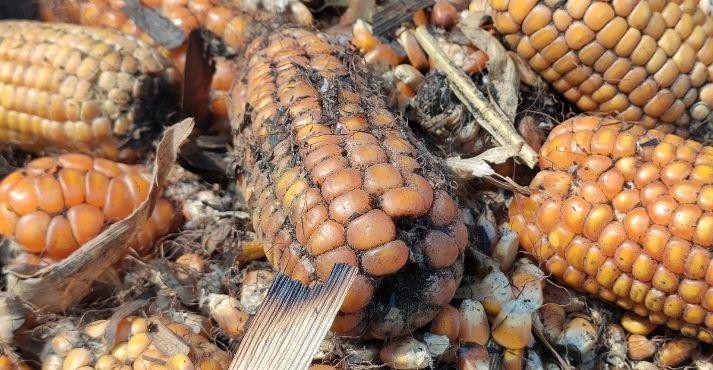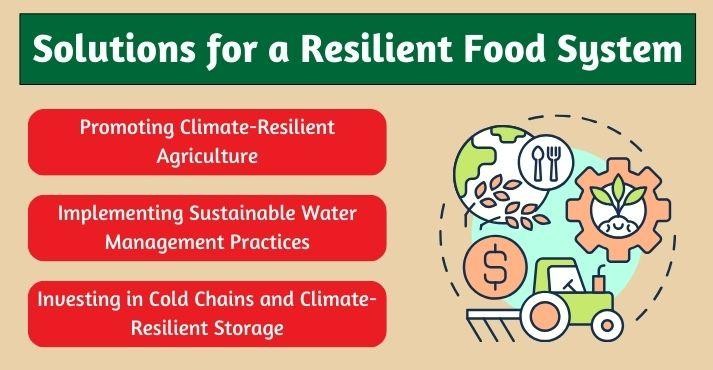Climate change is one of the greatest threats to global food systems, with profound impacts on agricultural productivity, food distribution, and access to nutrition.
The consequences are particularly severe in Southeast Asia, a region heavily reliant on agriculture and fisheries.
According to reports by the World Meteorological Organization, rising temperatures, unpredictable rainfall, and extreme weather events are causing crop failures, disrupting food supply chains, and threatening regional food security.
Food security is defined by its availability, accessibility, and utilization. However, climate change is increasingly compromising food security.
For instance, rice yields in the Philippines and Vietnam have declined due to erratic weather. At the same time, ocean acidification threatens fisheries in Indonesia and Malaysia.
Considering the above, this article explores the impact of climate change on food security, focusing on its effects on agriculture, access, nutrition, and potential solutions.
What is Food Security?

Food security refers to ensuring that everyone has consistent access to sufficient, safe, and nutritious food to maintain a healthy life. It is built on four pillars:
- Availability: Ensuring a stable supply of food through production and imports.
- Access: Ensuring food is economically and physically accessible to all.
- Utilization: Using food efficiently, focusing on nutrition and food safety.
- Stability: Maintaining consistent availability and access over time.
In Southeast Asia, food security is increasingly threatened by climate change. With many countries reliant on agriculture and fisheries, food production and distribution disruptions have far-reaching effects, particularly for low-income communities.
Governments and regional organizations strive to address these challenges, but the rising frequency of extreme weather events and environmental degradation complicates their efforts.
How Climate Change Impacts Food Security?

Climate change’s impact on food security manifests through various challenges, from declining crop yields to damaged ecosystems and disrupted supply chains.
Let’s explore some of the most pressing issues.
1. Rising Temperatures and Crop Productivity
Higher temperatures directly affect the productivity of staple crops like rice, maize, and palm oil. In Southeast Asia, where rice is a dietary staple, heat stress has caused significant yield reductions.
For instance, studies reveal that every 1°C increase in temperature can reduce rice yields by up to 10%. Similarly, palm oil plantations in Indonesia and Malaysia face declining productivity due to prolonged droughts and extreme heat.
Moreover, higher temperatures also accelerate the growth of pests and diseases, further threatening crops.
2. Extreme Weather Events and Agricultural Disruptions
Extreme weather events such as typhoons, floods, and droughts disrupt agricultural production across Southeast Asia. Typhoon Haiyan, which struck the Philippines in 2013, caused widespread destruction of rice and coconut plantations, leaving millions of people food-insecure.
These events reduce food production and increase food scarcity in affected regions. Disasters damage infrastructure, making it harder to transport goods, and force farmers to abandon lands, further exacerbating the impact of climate change on food security.
3. Soil Degradation and Salinization
Rising sea levels caused by climate change lead to soil salinization in low-lying agricultural regions.
Coastal areas like Vietnam’s Mekong Delta are particularly vulnerable. Seawater intrusion reduces the fertility of farmland, affecting crops such as rice, which is highly sensitive to salinity.
Additionally, soil degradation from over-farming and deforestation exacerbates the problem. Farmers face declining yields and are forced to adopt costly measures, such as using saline-resistant seeds or abandoning traditional crops.
This demonstrates how climate change affects food production by undermining the quality of arable land.
4. Impact on Fisheries and Marine Resources
Fisheries and marine ecosystems are critical to Southeast Asian diets, but ocean warming and acidification are increasingly threatening them.
Rising sea temperatures disrupt fish migration patterns and breeding cycles, leading to declining fish stocks. Coral bleaching caused by higher temperatures further depletes marine habitats, impacting fish populations.
For example, declining tuna stocks in Indonesia have forced fishermen to venture further into the ocean, increasing costs and reducing profits. These challenges highlight the critical role of climate change and agriculture in shaping food security.
Impact of Climate Change on Food Access and Prices

The impact of climate change on food security extends beyond agricultural production, significantly influencing access to and affordability of food. Supply chain disruptions, rising prices, and social inequalities exacerbate food insecurity among vulnerable communities.
As climate-induced challenges grow, food systems face increased pressure to maintain consistent access and affordability for all. Let’s explore how these dynamics unfold and deepen the challenges of ensuring equitable food security.
1. Supply Chain Disruptions and Accessibility Issues
Climate change disrupts the transportation and logistics systems crucial for moving food from farms to markets. Extreme weather events such as typhoons, floods, and droughts damage infrastructure, delay shipments and increase transportation costs.
In Southeast Asia, where many countries rely heavily on imports to meet domestic food needs, these disruptions pose severe challenges to accessibility and affordability.
For example, typhoons in the Philippines often destroy key export crops like rice, leading to shipment delays and increased costs for importing nations such as Singapore.
Similarly, in Singapore, where over 90% of food is imported, such disruptions highlight the fragility of food systems. Delayed shipments and damaged goods lead to increased reliance on alternative, often more expensive, sources, affecting consumers’ purchasing power.
2. Increased Food Prices Due to Production Challenges
Lower crop yields caused by extreme weather events and environmental degradation contribute to food inflation across Southeast Asia.
As climate change continues to disrupt agricultural production, food prices rise, making it increasingly difficult for low-income households to afford essential staples.
For instance, severe droughts in Vietnam have reduced rice yields, causing spikes in rice prices—a staple food for millions in the region. These price increases directly impact household budgets, especially for lower-income families who spend a larger proportion of their income on food.
“As income inequality continues to rise and is compounded with the climatic horrors that lie in wait, restaurants, like every other segment of society, will reflect the consolidation of wealth and the exploitation of the poor. The rich will be able to afford craftsmanship, ethical meat, fresh vegetables, etc., while the less wealthy will be forced into heavily industrialized food products from multinational companies.”
Joshua David Stein, Editor and author
This insight underscores the disparity caused by food and climate change dynamics. Wealthier populations can afford premium products, such as organic vegetables and sustainably sourced seafood, while lower-income groups are pushed toward cheaper, less nutritious options.
These trends highlight the need for targeted interventions to address how climate change affects food security and reduce the burden on vulnerable populations.
3. Food Inequality and Vulnerable Communities
The impacts of climate change disproportionately affect low-income communities and rural areas, exacerbating food inequality.
Limited access to nutritious food forces these populations to rely on less healthy, processed options, increasing rates of malnutrition, obesity, and diet-related illnesses.
In Cambodia, for example, rural farmers grappling with prolonged droughts report difficulty accessing fresh vegetables and protein sources.
Water shortages limit their ability to grow their own food and drive up the cost of market goods, leaving many families with insufficient access to balanced diets.
This contributes to growing levels of malnutrition, especially among children, who are particularly vulnerable to the long-term effects of poor nutrition.
Urban areas are not immune to these challenges. In Indonesia, residents in low-income urban neighborhoods face skyrocketing prices for staple foods due to disrupted supply chains and reduced production.
As we can see, vulnerable communities face reduced access to nutritious food, leading to poorer health outcomes and increased dependence on low-quality alternatives.
Addressing these inequalities requires a comprehensive approach that considers climate change and agriculture’s socio-economic impacts.
Nutritional Quality of Food and Climate Change
The impact of climate change on food security extends to the nutritional quality of available food, affecting public health across Southeast Asia.
Nutrient Loss in Key Crops
Elevated CO₂ levels associated with climate change reduce the nutritional content of staple crops. Studies show that rice, a dietary cornerstone in the region, contains lower protein, iron, and zinc levels when grown under high CO₂ conditions.
This poses significant health risks, particularly for populations already facing nutritional deficiencies.
Reliance on Processed Foods Due to Food Scarcity
As food scarcity worsens, reliance on processed foods increases. These products often lack essential nutrients and contribute to diet-related illnesses such as obesity and diabetes.
In urban centers like Jakarta and Manila, processed food consumption rises as fresh produce becomes less accessible due to climate disruptions. This will eventually result in poor health for the overall population.
Climate Change and Food Utilization: Impact on Food Safety

The impact of climate change on food security extends beyond production and access; it also affects how food is utilized. Climate change exacerbates risks to food safety by increasing spoilage, contamination, and waste.
The effects are particularly severe for regions like Southeast Asia, where tropical climates and resource constraints already pose challenges. Ensuring food remains safe and nutritious requires investments in storage infrastructure, innovative technologies, and sustainable practices.
Increased Food Spoilage and Contamination Risks
Rising temperatures and unpredictable weather conditions significantly increase the risk of food spoilage and contamination.
In tropical regions, where humidity levels are naturally high, warmer temperatures accelerate the degradation of fresh produce, meat, and dairy products.
For example, leafy vegetables wilt quickly under high heat, while seafood becomes unsafe for consumption without proper refrigeration.
This rapid spoilage leads to increased food waste, compounding food scarcity challenges.
According to research, an estimated 30% of food in Southeast Asia is wasted, and this number is expected to rise with higher temperatures caused by climate change. This waste not only affects food availability but also undermines sustainability efforts.
Contaminated food poses additional health risks. Warmer temperatures promote the growth of pathogens like Salmonella and E. coli, which can cause foodborne illnesses.
Addressing these risks is critical for maintaining food safety in the face of food and climate change challenges.
Challenges for Food Storage and Cold Chains
Cold chains, temperature-controlled networks for storing and transporting perishable goods, are vital for preventing spoilage. However, many Southeast Asian countries face significant barriers to developing these systems.
The high costs of building and maintaining cold storage facilities are a major obstacle, particularly in rural areas.
Farmers and small-scale producers often lack access to cold storage, forcing them to sell their produce quickly, sometimes at lower prices, to avoid spoilage. This limits their ability to maximize profits and contribute to stable food supplies.
In urban areas, insufficient cold-chain capacity leads to frequent disruptions in the food supply chain, further increasing food waste.
Another challenge is the strain on energy resources. Cold storage systems require significant electricity, but many Southeast Asian regions need help with energy access or face high costs for reliable power.
Innovations in food preservation offer promising solutions to these challenges. Solar-powered cold storage units, for example, provide an energy-efficient alternative for rural communities with limited access to electricity.
These reduce dependency on energy-intensive cold chains while addressing the risks of contamination and spoilage.
Adapting to Climate Change: Solutions for a Resilient Food System

Building resilience against climate change’s impact on food security is essential for ensuring stable food systems and equitable access to nutrition.
As climate change disrupts agriculture, water availability, and food distribution, innovative strategies and collaborative efforts are key to adaptation.
From implementing sustainable agricultural practices to developing robust cold-chain infrastructure, these solutions aim to create a resilient and secure food system for Southeast Asia and beyond.
1. Promoting Climate-Resilient Agriculture
Adopting sustainable agricultural practices is one of the most effective ways to mitigate the effects of climate change on food production.
Climate-resilient agriculture includes crop rotation, drought-resistant crop varieties, agroforestry, and precision farming. These practices improve soil health, conserve resources, and increase the adaptability of farming systems to changing weather patterns.
Additionally, drought-resistant crops, such as high-yield rice varieties developed for arid conditions, offer a lifeline for farmers in water-scarce regions.
Precision agriculture, which uses technology like drones and sensors, allows farmers to optimize water and fertilizer use, improving efficiency and reducing waste.
The “30 by 30” initiative is a prime example of innovative agricultural planning in Singapore. This ambitious program aims to produce 30% of the nation’s nutritional needs locally by 2030.
Singapore is leveraging limited land to boost food production through urban farming techniques such as vertical farming, hydroponics, and aquaponics.
This aligns with the goals of sustainable agriculture while reducing dependence on imports, increasing food security, and addressing food and climate change concerns.
2. Implementing Sustainable Water Management Practices
Water scarcity is a pressing issue in Southeast Asia, where agriculture relies heavily on consistent water availability.
Sustainable water management practices, such as rainwater harvesting, efficient irrigation systems, and wastewater recycling, are essential for reducing climate change’s impact on agriculture.
Rainwater harvesting involves capturing and storing rainwater for agricultural use. This simple yet effective technique helps farmers supplement their water supply during dry seasons, ensuring that crops receive adequate hydration.
In regions like northern Thailand, farmers have successfully implemented rainwater harvesting to stabilize crop production despite irregular rainfall patterns.
Efficient irrigation systems, such as drip irrigation, deliver water directly to the roots of plants, minimizing evaporation and runoff. This method is particularly effective in arid areas where water conservation is critical.
Wastewater recycling is another promising solution. Treated wastewater can be safely reused for irrigation, reducing the strain on freshwater resources. This practice is gaining traction in urban areas where water scarcity is exacerbated by population growth and industrial activity.
3. Investing in Cold Chains and Climate-Resilient Storage
Food storage and transportation systems are vital components of any resilient food system, particularly in the face of climate change.
Rising temperatures and extreme weather events increase the risk of food spoilage, making cold-chain infrastructure—temperature-controlled storage and transport systems—essential for maintaining food quality and safety.
Cold chains are critical for perishable items such as fruits, vegetables, dairy, and seafood, ensuring these products remain fresh from farm to table.
Food spoilage leads to significant waste without adequate cold storage, exacerbating the challenges posed by food scarcity. Investing in sustainable cold-chain technology can mitigate these risks, particularly in regions with limited infrastructure.
Singapore has emerged as a leader in this area, investing heavily in energy-efficient cold storage systems. These innovations reduce the environmental impact of traditional cold chains while maintaining food quality.
Policy Support and Regional Collaboration for Food Security
Policy interventions and regional cooperation are crucial for combating the impact of climate change on food security in Southeast Asia.
As climate-induced disruptions to agriculture, fisheries, and food supply chains intensify, coordinated efforts among governments and regional organizations play a vital role in building resilience.
These policies aim to protect livelihoods and ensure equitable access to food resources, from supporting farmers with sustainable practices to forwarding regional food security agreements.
ASEAN Initiatives for Food Security
The Association of Southeast Asian Nations (ASEAN) has proactively addressed food security through collaborative initiatives.
One notable effort is the ASEAN Food Security Reserve, which establishes a rice buffer stock among member countries to stabilize food supplies during crises.
This agreement allows nations like Indonesia, Vietnam, and Thailand to share resources during crop failure, ensuring no country faces severe shortages.
In addition to the reserve, ASEAN promotes research and development in sustainable agriculture, encouraging the adoption of technologies like drought-resistant crops and improved irrigation systems.
Policies for Sustainable Agriculture and Fisheries
Southeast Asian governments have implemented policies to support sustainable agriculture and protect vital marine ecosystems.
In the Philippines, for instance, programs focused on rehabilitating coral reefs are helping to restore fish habitats and ensure a steady supply of marine resources. Sustainable fishing practices, such as limiting overfishing and reducing bycatch, are also being promoted to safeguard biodiversity.
The “30 by 30” initiative in Singapore seeks to improve local food production by leveraging urban farming and advanced technologies. These policies aim to reduce dependence on imports while encouraging innovation in food and climate change solutions.
Together, these measures highlight the importance of combining national policies with regional collaboration to tackle the challenges posed by climate change and agriculture.
Conclusion
Climate change’s impact on food security is an urgent challenge that requires immediate and coordinated action. Rising temperatures, extreme weather events, and disrupted supply chains threaten food availability, access, and nutrition across Southeast Asia.
Addressing these vulnerabilities is critical to building a resilient food system that can withstand the pressures of a changing climate.
Southeast Asia must prioritize sustainable agricultural practices, boost local food production, and invest in climate-resilient infrastructure. These efforts, combined with policies supporting equitable food distribution, can mitigate the risks of climate change.
The region can safeguard food systems for future generations by adopting innovative solutions and prioritizing sustainability.
The time to act is to ensure a secure, equitable, and sustainable food future. Addressing the impact of climate change on food security is essential for protecting both people and the planet.





























